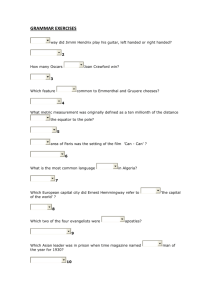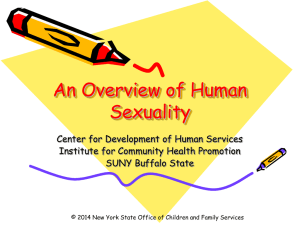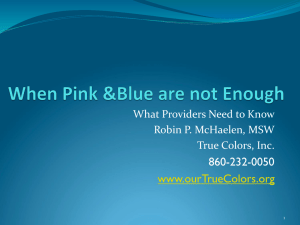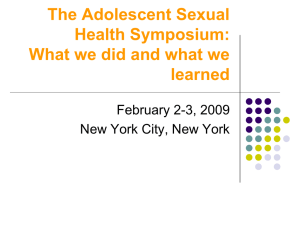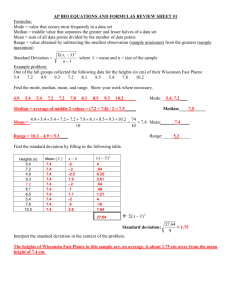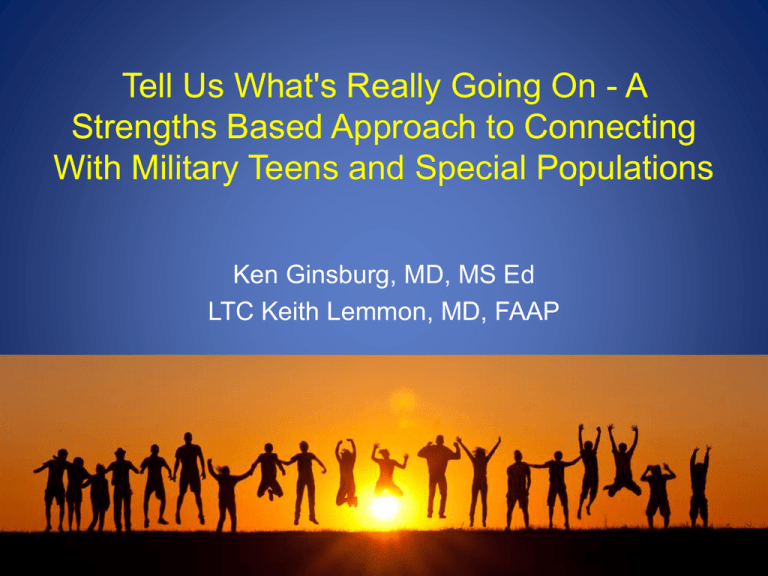
Tell Us What's Really Going On - A
Strengths Based Approach to Connecting
With Military Teens and Special Populations
Ken Ginsburg, MD, MS Ed
LTC Keith Lemmon, MD, FAAP
Department of Defense Disclaimer
• The opinions or assertions contained in this
presentation are the private views of the
presenter and are not to be construed as official
or as reflecting the views of the Department of
Defense
Participant Outcomes
• Be able to discuss the fundamentals of a strengths
based approach to psychosocial health screening in
military adolescents
• Discuss the most common causes of injury and death in
the adolescent population and describe effective
connection and communication strategies that are most
likely to mitigate these risks.
• Identify the unique challenges that sexual minority youth
face in their military family, educational, and health care
environments.
• Discuss effective ways to support sexual minority youth
in developing a healthy sense of identity that will lead to
successful adult lives.
The Military Adolescent Experience
Keeping the Promise
• Caring for warrior families
• Creating an environment for
military kids to see military
service as a viable stepping stone
or career
• Preparing military kids to be
successful as adults
• Children from military families
are 2x more likely as their
civilian counterparts to serve in
the Armed Forces as Adults
The Military Adolescent Experience
• Over 2 million children of service members in the
Active Duty, National Guard and Reserves
• Almost 4 million children and youth including
those of post 9/11 Veterans
• Over 2 million children have a parent who has
served in Afghanistan or Iraq – many have
served multiple times
The Military Adolescent Experience
• Military-connected children move 6-9 times
during their K-12 education.
• 27% of both Active Duty and National Guard and
Reserve Forces children are between the ages
of 12 and 23
• Available research suggests that current military
service and recurrent deployments are stressful
to military families and have at least some short
term adverse effects on mental health and
functioning
The Military Adolescent Experience
• Military youth live the
concept of service and
sacrifice every bit as
much as their military
parent
• Expected to take on more
advanced family roles
when family members are
away
• May live in environment
where parent is absent –
physically or emotionally
Toxic Stress and Adverse Childhood
Experiences
• Young children who experience toxic stress are
at high risk for a number of health outcomes in
adulthood, including cardiovascular disease,
cancers, asthma, and depression
• Recent developments in the understanding of
the neuroendocrine-immune network, how its
function is altered by early life adversity, and
how these alterations then increase vulnerability
to disease.
Toxic Stress and Adverse Childhood
Experiences
• Early environments shape and calibrate the
functioning of biological systems very early in life
• Even in the most extreme cases of adversity, welltimed changes to children’s environments can
improve outcomes
• Youth serving professionals are in a unique position
to contribute to explain how factors that seem
distant from child health may be the key to some of
the most intractable public health problems of our
generation.
American Academy of Pediatrics Center on
Healthy Resilient Children
• A national effort coordinated by the AAP and
strategic partners to support healthy brain
development and prevent toxic stress
• Focus on prevention efforts as well as identifying
children who have experienced adversity and
toxic stress and insure they have access to
appropriate interventions and support
American Academy of Pediatrics – Resources for
Military Teens and Youth Serving Professionals
• Reaching Teens – America’s Children Chapter
• Deployment and Military Youth Medical Home
Resource Website - http://www.aap.org
• Health and Mental Health Needs of Children in
US Military Families – 2013 Clinical Report
The Military Child and Adolescent
Deployment Support Video Program
View the videos at : www.aap.org/sections/uniformedservices/deployment/index.html
MilitaryKidsConnect.Org
Left Handed People
Left Handed - Then
• Dave was born in 1954. His parents assumed
he would be just like them – right handed. It
wasn’t something they ever even thought about.
Everyone was right handed. They knew there
were left handed people, but they had never met
one. They were just people that needed to be
made to stop using their left hand and start using
their right hand.
Left Handed - Then
• If his parents had ever thought about it, they
would have noticed he favored his left hand.
When he started school, the teacher noticed, but
she made him write with his right hand, use right
handed scissors, and paint and color with his
right hand. It wasn’t acceptable to use your left
hand – it was just wrong. No one could say why,
that’s just how it was.
Left Handed - Then
• Dave knew he was different, before he even
knew why. He could tell there was something
about himself that was different, that everyone
said was wrong.
• He learned to use his right hand around other
people, but it never felt – right.
• When he was alone he would use his left hand,
but he would always feel guilty, and sad
Left Handed - Then
• Eventually, he met other left handed people.
When he was with them, he didn’t have to
pretend anymore. He finally understood that it
was OK to be left handed. That he was OK. He
didn’t have to be ashamed.
• He finally told his parents what they already
knew, but didn’t want to admit. He was left
handed.
Left Handed
• 1988 study found 7 to 10% of the US adult
population is left handed
• Left handed negativity:
– In ancient Hebrew and other cultures, the left hand
symbolized the power to shame society, and was
used as a metaphor for misfortune, natural evil, or
punishment from the gods
– Persisted and integrated into Christianity
*Wikipedia
Screening for risk . . .
. . . but always while recognizing
strengths
Strengths
School
Home
Activities
Drugs and other Substances
Emotions and Eating
Sexuality
Safety
Jonah Mowry Video
The Era of Changing Social Constructs
Regarding Sexual Minorities
• "Don't ask, don't tell" (DADT) was the official
United States policy on service by gays and
lesbians in the military instituted in February 28,
1994 lasting until September 20, 2011.
• The policy prohibited military personnel from
discriminating against or harassing closeted
homosexual or bisexual service members or
applicants, while barring openly gay, lesbian, or
bisexual persons from military service.
Changing Social Constructs
• Legislation to repeal DADT was enacted in December
2010
• Training focused on treating all service members equally
with dignity and respect.
• President Barack Obama, Secretary of Defense Leon
Panetta, and Chairman of the Joint Chiefs of Staff
Admiral Mike Mullen sent certification to Congress on
July 22, 2011, which set the end of DADT to September
20, 2011.
Defense of Marriage Act (DOMA)
• The Defense of Marriage Act (DOMA) (Pub.L.
104–199, 110 Stat. 2419, enacted September 21,
1996, 1 U.S.C. § 7 and 28 U.S.C. § 1738C) is a
United States federal law that allows states to refuse
to recognize same-sex marriages granted under the
laws of other states.
• Until Section 3 of the Act was ruled unconstitutional
in 2013, DOMA, in conjunction with other statutes,
had barred same-sex married couples from being
recognized as "spouses" for purposes of federal
laws, effectively barring them from receiving federal
marriage benefits.
Defense of Marriage Act (DOMA)
• The Obama administration announced in 2011
that it had concluded Section 3 was
unconstitutional and that although the
administration would continue to enforce the law
while it existed, it would no longer defend the
law in court. In United States v. Windsor (2013),
the U.S. Supreme Court declared Section 3 of
DOMA unconstitutional under the Due Process
Clause of the Fifth Amendment.]
Marriage Equality
•
•
•
•
•
•
•
•
•
•
California
Connecticut
Delaware
Illinois
Iowa
Maine
Maryland
Massachusetts
Minnesota
New Hampshire
•
•
•
•
•
•
•
•
•
•
New Jersey
New Mexico
New York
Pennsylvania
Rhode Island
Vermont
Washington
Illinois
Hawaii
D.C.
American Academy of Pediatrics Policy
Statement – March 20,2013
• Committee on Psychosocial Aspects of Child and
Family Health
• Promoting the Wellbeing of Children Whose Parents
are Gay or Lesbian
• The AAP supports access for all children to (1) civil
marriage rights for their parents, (2) willing and
capable foster parents regardless of their sexual
orientation
American Academy of Pediatrics Policy
Statement – June 24th,2013
• Committee on Adolescence
• Office Based Care for Lesbian, Gay, Bisexual,
Transgender, and Questioning Youth
• Acknowledging resilience but health disparities
• Encouraging Sexual Minority friendly spaces
• Setting the expectation that SMY should be able
to have healthy, happy transitions through
adolescence and young adulthood
Caring for Sexual Minority Youth in the Military
and Military Families
What is Healthy Sexuality?
• Sexual development and growth is a natural part
of human development
• Healthy sexual expression is different than
sexual risk
• Same-sex behavior is included in the realm of
healthy sexuality
Determination of Sexual Orientation
• Sexual orientation is not a choice
• Most likely determined by combination of
influences:
– Genetic
– Hormonal
– Environmental
Sexual
Attraction/Orientation
Sexual Behavior
Paradigm
of Sexuality
Biologic Sex
Gender
Identity/Expression
Confronting Personal Biases
Understanding Personal
Biases
Provider discomfort can
be damaging
It is an ethical obligation
to refer patients for
appropriate care
Depression
•
•
•
•
Rejected by society
Rejected by family
Rejected by friends
Internalized homophobia and self-hatred
Suicide
• Suicide is the leading cause of death among gay
& lesbian youth
• Approximately 30% of all adolescent suicides
are gay and lesbian youth
• School victimization correlates with suicidality
• Most attempts are during Identity Confusion
stage
Suicide
• Mean age at attempting is 15.5 years
• 50% of all gay and lesbian youth have made at
least one attempt
• Loss of friends increases risk 3 to 7x
School Harassment
• GLSEN 2011 National School Climate Survey
– 81.9 % of LGBT Students have been verbally
harassed
– 38.3% physically harassed (18.3% assaulted)
– 63.5% report they feel unsafe in school
– 31.8% miss school due to safety concerns in the last
month (6.7% school average)
School Harassment
• LGBT youth who report significant verbal abuse
at school have lower GPAs and are less likely to
report plans to go to college
• When students can identify supportive staff
members at school, the number that plan to go
to college increases significantly
Accepting school environment
• Gay-Straight Alliance in the school resulted in
fewer homophobic remarks, less victimization,
less absenteeism, greater sense of belonging
• Supportive staff results in feeling safer, fewer
absences, greater academic achievement
• Accepting Families !!!!!!
How Can We Create a Safe Space?
Train all staff
Zero tolerance
for insensitivity
Provide support
resources
Assure
confidentiality
Display GLBTQ
affirming
materials
Resilience of GLBTQ Youth
• Many GLBTQ teens lead normal, healthy and
productive lives
• Usually develop resilient adaptations to social
biases and mistreatment
• Many develop and possess remarkable strength
and self determination
Resources for Sexuality Minority Youth, Their
Families, and Youth Serving Professionals
• TheTrevorProject.org
• “It gets better” campaign
• The Gay, Lesbian & Straight Education Network
GLSEN.org
• Family Acceptance Project:
www.familyproject.sfsu.edu/
• PFLAG – Parents and Friends of Lesbians and
Gays – www.pflag.org
• Outserve.SLDN.org
Behavioral Change 101
(What they’re missing)
The Five Steps of Behavioral Change
1. Awareness
2. Motivation
3. Skills
4. Trial and Error
5. Maintenance
Confidence gets it started…
…and shame paralyzes all efforts
Finding Competence…
…Building Competence
Help youth know how much they
matter
Recognize the credentials they
bring to the world
Do the work it takes to love
The second sentence
Recognize…
Youth as experts in their own lives who
have the capacity to heal and find the
solutions within themselves.
Sensitized youth as our future healers
and leaders.
Know who we are…
We are the borders
We are the picture on the box


